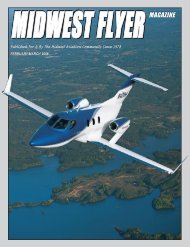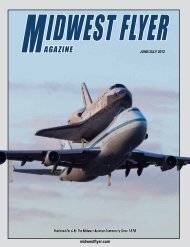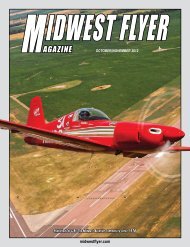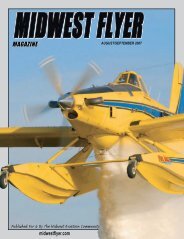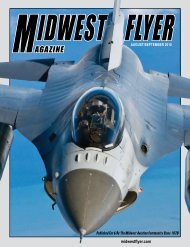Midwest Flyer Magazine
Midwest Flyer Magazine
Midwest Flyer Magazine
- No tags were found...
Create successful ePaper yourself
Turn your PDF publications into a flip-book with our unique Google optimized e-Paper software.
Some suggestions to Clem’squestion would be to developa recurrent training programfor CAP pilots, and simulatortraining might be an alternative,though none of these ideasare inexpensive, but the newRedbird simulator has helped.There is a Redbird that I usewhen training a new instrumentpilot, located at the Tomahawk,Wisconsin airport. Now, severalothers, which are availableto rent, are located in otherlocations in Wisconsin as well.Last year, I elected to take atraining course on the GarminG1000-equipped Bonanza(G36) at Flight Safety inWichita. It was an excellent course lasting a week at a costof 7 + AMUs (Aviation Monetary Units where one AMU =$1000.00), not including hotel or transportation. Even afterexcellent training, if you are not totally immersed in flyingthis package on a regular basis, you soon forget some of the“buttonology” of this box as I have.Another topic that was discussed at the Volk seminar andmentioned above was “Summer Thunderstorm Flying.” Thiswas prompted by the publication of the investigation intoa Bonanza accident where the pilot seriously damaged oneaircraft, totaled another, and killed himself in the third – allinvolved flying in thunderstorms. I lost a friend, who was awell-known and experienced test pilot, Scott Crossfield, ina similar accident some years ago. Another very recent anddisastrous thunderstorm accident involved a Pilatus nearLakeland, Florida, which killed all six persons on board. Oneinstructor, who works with me in the Beechcraft program, isalso an insurance claims adjuster in Florida. His comments, aswell as the preliminary NTSB report, indicated that weatherwas the probable cause of the in-flight break-up of the aircraft.A most important tip to pilots who may be dealing withthunderstorms is #1, avoid them if at all possible! If thisis not an option, which can happen on a rare occasion, itis sometimes better to remain below the cloud base andstay VFR. That way you can visually avoid the heaviestprecipitation and the accompanied turbulence. It wasthe turbulence that was responsible for all of those fatalthunderstorm accidents.While we were discussing weather at the Volk seminar,the topic of the new Stratus weather avoidance tool availableexclusively from Sporty’s Pilot Shop was mentioned. Thisunit has received great reviews and is subscription-free withuplinked weather provided by the FAA through ADSB(Automatic Dependent Surveillance-Broadcast). The weatheris displayed through a wireless link to any iPad, iPod oriPhone running the Foreflight application. I will cover ADSB0.""#$%$&'(&)*')+,)-"./0.""+123)&'"456)-"+#%#718)"""and the Stratus unit once I havethe opportunity to review itpersonally. At this time, I ampersonally using a Garmin 396with satellite (down-linked)weather from the XM weathersatellite.Now, I will continue the coretopic of helpful tips on flyingthe popular Garmin 430/530box and the use of the OBSbutton from my previous article.In order to make use of theOBS mode, your avionics shopmust install a compatible VORindicator, conventional HSI ora glass primary flight display(PFD). Many of the older VORindicators do not have thecapability of feeding back what the pilot sets on the CDI tothe GPS box; this is referred to as “bootstrapping.” If you haveever noticed when your flight course changes on your GPS,a message light flashes and tells you what to set your CDI toif you had not done it previously. This feedback informationon an HSI is also given to other devices. For example, astormscope can be slaved so it indicates the relationship ofthe weather to the aircraft’s heading as it changes. When thepilot selects the OBS function while enroute and not part ofan approach, you have created a course line from a waypoint.That waypoint can be a VOR, intersection, airport or awaypoint created by the pilot to fulfill his or her needs. Let’stake a look at some practical applications for doing this.When approaching an unfamiliar airport VFR, especiallyduring times of reduced visibility, the pilot can create anextended centerline to the runway to aid in his approach tothe airport and landing.First, make the airport the go-to waypoint. Look up theairport runway configuration in the Airport Facility Directoryor other paper or electronic data source.The next step is to push the OBS button and rotatethe HSI or CDI to the landing runway number. If all is setcorrectly, the GPS map page should show a magenta-coloredextended centerline of the landing runway.I have seen on rare installations that there is a large delayin the positioning of this line on the GPS. Remember thatthis line may not depict the centerline of the runway becauseit is based on the geographical center of the airport.As with the task of runway orientation, you can use asimilar technique for non-published holding patterns.I have shown many instrument pilots this procedure andhow to automate this with the autopilot. As with the runwayorientation, you select the fix you will be holding at with thedirect-to sequence. Then use the OBS on your VOR indicatoror HSI to select the inbound holding course, NOT the radial.The inbound course on your moving map page should be



